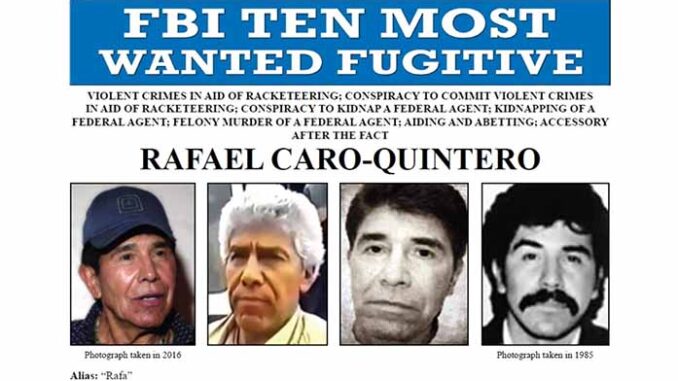
More than a dozen Mexican military members died last week in a special operation which led to the recapture of the man responsible for the torture and murder of U.S. DEA Special Agent Enrique “Kiki” Camarena in Mexico in 1985.
The arrest of Rafael “Rafa” Caro Quintero was announced Friday by DEA Administrator Anne Milgram in a message sent to all field offices.
“Our incredible DEA team in Mexico worked in partnership with Mexican authorities to capture and arrest Rafael Caro Quintero,” Milgram said. “Today’s arrest is the result of years of your blood, sweat, and tears.”
U.S. authorities say Caro Quintero, 69, was tracked in the Sinaloa mountains near Chihuahua by Mexican military members working with a specially trained dog. No Americans were involved in the actual tactical operation, according to U.S. Ambassador to Mexico Ken Salazar.
“The apprehension of Caro Quintero was exclusively conducted by the Mexican government,” Salazar stated Saturday. “This achievement is a testament to Mexico’s determination to bring to justice someone who terrorized and destabilized Mexico during his time in the Guadalajara Cartel; and is implicated in the kidnapping, torture and murder of DEA agent Kiki Camarena.”
Caro Quintero was reportedly arrested on two Mexican court orders as well as the U.S. extradition warrant. The operation centered on the San Simon village of 200 persons in Chihuahua near the border with Sinaloa. The 14 Mexican marines who died were in a support helicopter which crashed near Los Mochis in northeastern Sinaloa
The timing of Caro Quintero’s arrest has also garnered attention, given that it came just three days after Mexico’s president, Andrés Manuel López Obrador, met at the White House with President Joe Biden.
For now, Caro Quintero is expected to be held at a maximum security facility in southern Mexico until his extradition to the U.S. can be arranged. In addition to federal charges pending in New York, Caro Quintero is also a defendant in a 30-year-old drug case in a California federal court.
Those who analyze the inter-workings of Mexican cartels have been quoted as saying the arrest will have no immediate impact on drug smuggling and the movement of undocumented immigrants. However, an uptick of violence could be seen along the U.S. southwest border as various factions of some cartels maneuver for power in an attempt to gain a foothold in new territory.
Caro Quintero purportedly gave the command for Camarena to be kidnapped in February 1985 in response to a large police raid on one of the Guadalajara Cartel’s properties months earlier. Camarena’s body, which showed obvious signs of torture, was found a month later.
The drug lord was taken into custody in 1985 and sentenced by a Mexican judge to 40 years in prison for the murder. However, his conviction was overturned on appeal in 2013 leading to his release. The DEA undertook a publicity campaign in 2014 to draw attention to the fact Caro Quintero was the subject of a $5 million reward offered by the U.S. State Department’s Narcotics Reward Program.
Later, the Mexico Supreme Court reinstated Caro Quintero’s 1985 conviction but by then he could not be found.
After his release from a Mexican prison in August 2013, Caro Quintero went back into drug trafficking as part of the Sinaloa Cartel then led by Joaquin “El Chapo” Guzman. U.S. officials later identified several persons, including his children, operating as a “Caro Quintero Organization” within the cartel.
In 2016, Caro Quintero was designated as a foreign narcotics kingpin by the U.S. Department of Treasury. This opened the door for the Treasury Department’s Office of Foreign Assets Control to engage in financial seizures.
One such seizure occurred last year in Brooklyn, New York where a federal judge signed a forfeiture order for five real estate properties in Guadalajara shown to be purchased with cartel money. Caro Quintero was accused of placing the properties in the names of family members to conceal his ownership and to prevent Mexican authorities from seizing the properties.
Then in 2018, the FBI pushed Caro Quintero onto its 10 Most Wanted list. At the same time, the reward was bumped to $20 million and began pressuring the Mexican government to comply with an extradition warrant signed by a federal judge in the U.S.
Last fall, a Mexico court rejected Caro Quintero’s appeal of the extradition warrant. The focus then turned to locating the once powerful drug lord. Whether the U.S. will have to pay someone the $20 million reward is as of now unclear.
Details as to the cause of the helicopter crash remain sketchy although one person onboard is believed to have survived.

